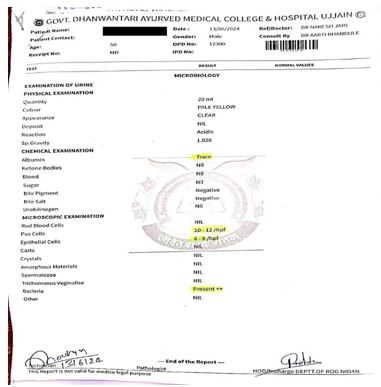A Case Study of Urinary Tract Infection and its Ayurveda Management
DOI:
https://doi.org/10.21760/jaims.9.8.51Keywords:
Mutrakriccha, Urinary Tract Infection, Micturition, Ayurveda MedicinesAbstract
A Urinary Tract Infection (UTI) is the most common bacterial infection encountered in daily medical practice. It is more prevalent in females than males due to the shorter urethra in females, which allows bacteria a quicker access to the bladder. One in five women develop UTI at least once in her lifetime. UTIs in men are uncommon, but when they do occur, they can be very serious. In Ayurveda, the symptoms of UTI closely resemble a condition known as Mutrakriccha. Acharya Charaka has explained eight types of Mutrakriccha in Charaka Chikitsa Sthana 26. In this condition, the aggravated Pitta Dosha, along with Apana Vayu, reaches the Vasti (bladder) and affects the Mutravaha Srotas, leading to painful and burning urination. In this case report, a 50-year-old male patient presented with symptoms of urinary urgency, increased frequency, and intermittent burning urination for the past 1-2 months. He was diagnosed with UTI and was effectively managed with Syp. Neeri, Chandraprabha Vati, Gokshuradi Guggulu, Shweta Parpati, and Hajaralyahud Bhasma. The treatment resulted in significant improvement in signs, symptoms, and urine examination results. During follow-up visits, there were no recurrences of UTI. Ayurvedic management offers a promising alternative for treating Mutrakriccha.
Downloads
References
2. Wald Braun Eugene, Anthony S, Fauciet, Harrison, Principles of Internal Medicine, Vol-2nd, 6th Ed. Mc Graw Hill, 2005, Pp1715.
3. R Alagappan, Manual of Practical Medicine, Fourth Edition 2011, Jaypee Brothers Medical Publishers, Chapter 7 Nephrology Page No. 401.
4. Yadavji Trikramji, Commentary of Chakrapani On Charaka Samhita of Agnivesh, (Chikitsa Sthana 26/ 32-35): Varanasi: Chowkhambha Sanskrit Series, 2013; Page No- 599
5. Murthy K, Sarangadhara Saṃhita, Varanasi: Choukhambha Orientalia (Madyamkhanda 7/ 40-44), 2009
6. Murthy K, Sarangadhara Saṃhita, Varanasi: Choukhambha Orientalia (Madyamkhanda 7/ 84-87), 2009.
7. Nayak B, Ayurvedline, Bangaluru, Ayurveda Kutiram, Proprietary Medicines Index, Page No. -584, 2017.
8. Dravyaguna Vijnana - Vegetable Drugs Of Prof. P.V. Sharma, Reprint 2017 Choukhmbha Bharti Academy Varanasi, Vol. 2nd Chapter 8 Mutravirechniya, Pg. No. 632.
9. Siddha Yoga Sangraha By Vaidya Yadavji Trikam Ji Acharya, Publication Shree Baidyanath Ayurveda Bhavan Nagpur, 2000, Chapter 18 Ashmari – Mutrakricchadhikar, Page 99.
10. Ayurvediya Rasashastra, Dr Chandrabhushan Jha, Publication Choukhabha Prakashan Varanasi, 2012, Sudha – Sikta Varga Page No. 449.















